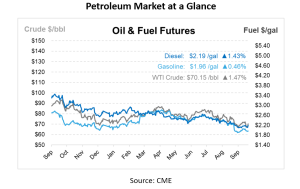
Oil Prices Drop as Libya Resumes Production
Oil prices fell by over 60 cents per barrel this morning after Libya announced plans to resume oil production following the appointment of a new central bank governor. Meanwhile, the escalating conflict between Israel and Lebanon is heightening concerns over stability in the Middle East, as Israeli forces launched targeted raids in southern Lebanon and carried out airstrikes in Beirut. In the U.S., oil production in the Gulf of Mexico is gradually recovering from disruptions caused by Hurricane Helene, with 3% of crude output still offline.
Overnight, Israeli troops entered Lebanon for targeted ground raids, and separate Israeli airstrikes in Beirut killed a senior Hamas leader. These actions have increased fears of broader regional conflict. In the meantime, Brent futures closed at $77.17 per barrel yesterday, showing little change day-over-day, as market participants weighed the conflicting signals of potential supply increases from Libya and regional risk factors.
In North America, the oil market is seeing its own shifts in production and import patterns. According to the US Bureau of Safety and Environmental Enforcement, US Gulf Coast oil output is steadily recovering after disruptions caused by Hurricane Helene, with only 3% of crude production still offline. This marks a significant improvement from earlier in September, when nearly 30% of oil output was shut down due to storm-related damages.
According to the EIA, in July, the US imports from Venezuela have surged to 308,000 barrels per day—the highest level since January 2019—after the Biden administration eased sanctions on the South American nation. Across the border, Canadian oil imports hit an all-time high of 4.373 million barrels per day, largely due to the recent expansion of the Trans Mountain pipeline. This boost in capacity is expected to provide a long-term increase in Canadian export volumes, reinforcing the country’s role as the first supplier to the US market.
While supply-side dynamics are shifting, demand signals are also evolving. US gasoline supplied to the domestic market rose to 9.3 million barrels per day in July, marking a 3.5% year-over-year increase and the highest level for this time of year since 2021. This indicates a recovery in consumer demand, likely driven by increased summer travel and economic activity. However, the diesel market remains under pressure as industrial demand has yet to fully recover, and international demand, particularly from China, has plateaued.
Further complicating matters, the US East and Gulf coasts are now facing significant logistical disruptions as the International Longshoremen’s Association (ILA) went on strike this morning, halting operations at 36 ports from Maine to Texas. This strike, the first large-scale stoppage by the ILA since 1977, is in response to failed negotiations with the United States Maritime Alliance (USMX) over wages and the use of automation. The disruption has effectively blocked about half of the nation’s ocean shipping capacity, impacting everything from food shipments to automobiles, and could cost the U.S. economy an estimated $5 billion per day if it continues. The White House has stated that it will not intervene, putting pressure on both parties to reach a resolution swiftly. Analysts predict that the strike could last for up to a week, with ripple effects potentially extending well into early next year, as supply chains struggle to adapt.
Amid supply chain challenges and geopolitical developments, the Federal Reserve’s recent stance on monetary policy adds another layer of uncertainty. Chairman Jerome Powell stated that the Fed is not in a hurry to cut interest rates, emphasizing the need to monitor labor market conditions. While Powell acknowledged that job gains have slowed, he reiterated that further cooling in the labor market is not necessary to achieve the Fed’s 2% inflation target. This suggests that the central bank will take a cautious approach to rate cuts, which could keep borrowing costs higher for the foreseeable future, impacting everything from energy investments to consumer spending patterns.
As the industry looks ahead, several key factors must be closely monitored, including the outcome of the U.S. dockworkers’ strike, ongoing developments in the Middle East, and the potential for renewed Libyan oil output. The next OPEC+ meeting, scheduled for early October, will also be a critical event, as the group reviews its production targets in light of the current supply-demand imbalance. With Brent crude prices currently hovering around $70 per barrel, the market remains on edge, and any unexpected news could trigger sharp price movements in the days to come.

This article is part of Daily Market News & Insights
Tagged:
MARKET CONDITION REPORT - DISCLAIMER
The information contained herein is derived from sources believed to be reliable; however, this information is not guaranteed as to its accuracy or completeness. Furthermore, no responsibility is assumed for use of this material and no express or implied warranties or guarantees are made. This material and any view or comment expressed herein are provided for informational purposes only and should not be construed in any way as an inducement or recommendation to buy or sell products, commodity futures or options contracts.





